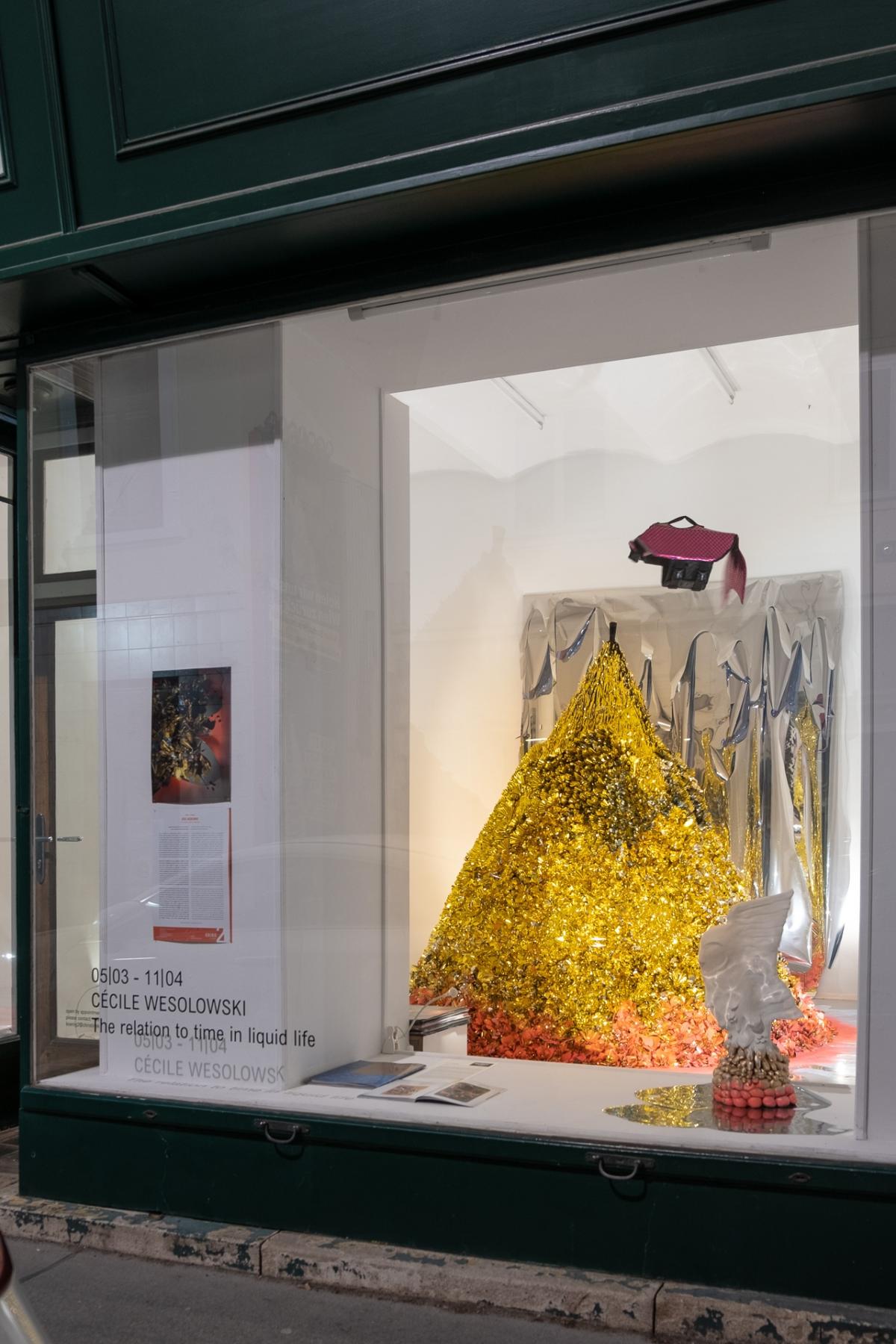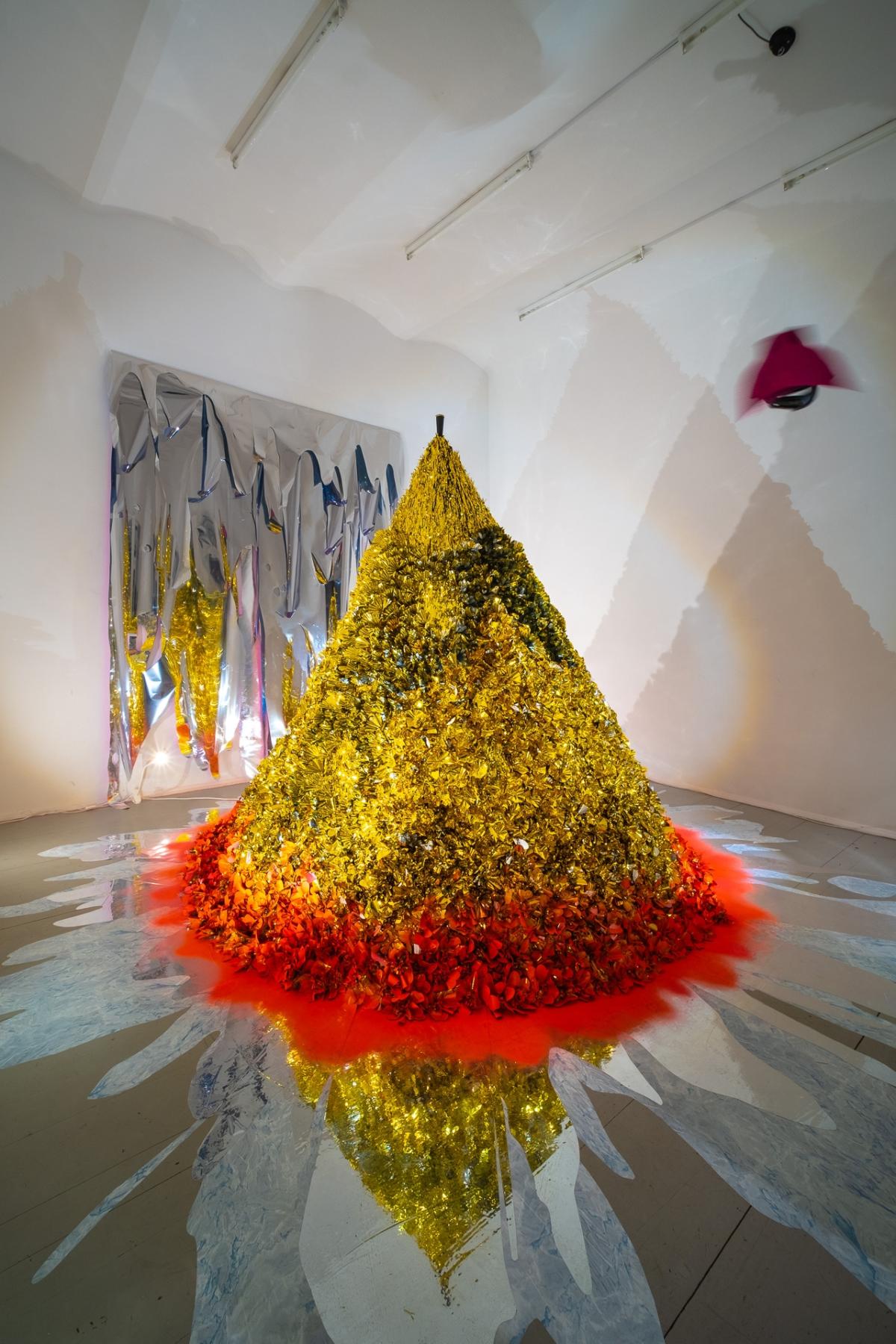[EN/DE] ‘The Relation to Time in Liquid Life’ by Cécile Wesolowski at KOENIG2 by_robbygreif
![[EN/DE] ‘The Relation to Time in Liquid Life’ by Cécile Wesolowski at KOENIG2 by_robbygreif](https://blokmagazine.com/wp-content/uploads/2020/05/koenig2-cecile-wesolowski-the-relation-to-time-in-liquid-life-web-00008-1200x1800.jpg)
[EN]
text by Andrea Kopranovic
translated from the German by Sarah Cormack
It seems paradoxical to imagine time as a constant, an unchangeable parameter in uncertain, volatile times. In the opinion of the sociologist Zygmunt Bauman, however, it is precisely this volatility, for which he uses the term “liquid”, that constitutes our contemporary era. Liquidity describes a quality in which that which is diaphanous takes the place of that which is solid, and longing is stronger than need. “Liquid life”, taken from Bauman’s 2005 publication on the theme, is likewise present in the title of Cécile Wesolowski’s first exhibition in Austria. The artist understands time as a constant flow that is able to make visible alterations in reality and personal perception. To this end, it must be sequenced into moments, whose concatenation is directed by a narrative structure – before, now, and afterwards. Thus time apparently becomes tangible.
Cécile Wesolowski manifests this longing in an extensive installation: a volcano covered with shining gold rocailles and decorative ornamentation serves as an ironic metaphor for sumptuous objects and precious wishes. Composed of meticulously folded and layered thermal blankets, which in French are called couverture de survie (survival blankets), the volcano is surrounded by mirror foil which, sensuously gleaming, extends into the room like liquid silver. The external neo-baroque appearance is deceptive, since from its interior dark bitumen is extruded, continually burying the shiny outer surface in gradual, arbitrary drops beneath its viscous mass. The staged destruction evokes a desire for a pausing or rewinding of time, a desire which in particular after losses – be they of love, capital or nature – remains unfulfilled in the ‘analogue’ reality beyond art and the digital world.
The irreversible consequence of the transformation of the work and the hallucinatory lights of the material have a dramatic effect. Two video works, suggestive of smart-phone recordings in their aesthetic and format, additionally increase this effect. A backwards-running hunting accident and the recording of a meteor, incessantly playing backwards and forwards in a loop, illustrate the unattainable wish to be able to correct mistakes in the past, to have a chance to alter the future. The images of longing are accompanied by a ceramic sculpture, a hybrid of the Greek kairos, the personified divinity of the favourable moment in time, and a Japanese daruma, who aids in fulfilling desires. Like a final, silent act of desperation, the daruma stands in the window. Neither he, nor the meteor nor the survival blankets can safeguard us against the fleetingness of time. In “The relation to time in liquid life”, Cécile Wesolowski depicts this painful feeling, whose gravity lies beneath false hopes and unfulfilled desires in a colourful illusory world.


[DE]
text von Andrea Kopranovic
Zeit als Konstante, als unveränderlichen Parameter, in unsicheren, flüchtigen Zeiten anzunehmen, scheint paradox. In der Auffassung des Soziologen Zygmunt Bauman ist es aber gerade diese Flüchtigkeit, für die er den Begriff “liquid” verwendet, die unsere gegenwärtige Zeit darstellt. Liquidität beschreibt eine Qualität, in der das Diaphane an die Stelle des Festen tritt und Sehnsucht stärker ist als Bedürfnis. “Liquid life”, eine von Baumans Publikationen zu dem Thema aus 2005, ist zugleich präsent im Titel von Cécile Wesolowskis erster Ausstellung in Österreich. Die Künstlerin versteht Zeit als einen konstanten Fluss, der Veränderungen der Realität und der persönlichen Wahrnehmung sichtbar machen kann. Dafür muss diese in Momente sequenziert werden, deren Aneinanderreihung von einer narrativen Struktur – davor, jetzt und danach – geleitet wird. Zeit wird so scheinbar greifbar.
Diese Sehnsucht manifestiert sich in der raumgreifenden Installation von Cécile Wesolowski: ein von goldglänzenden Rocaillen und Zierornamenten überzogener Vulkan dient als ironische Metapher für Preziosen und kostbare Wünsche. Bestehend aus minutiös gefalteten und geschichteten Rettungsdecken, im französischen couverture de survie (dt. Überlebensdecke) genannt, ist der Vulkan umgeben von Spiegelfolien, die sich wie flüssiges Silber sinnlich glänzend im Raum ausbreiten. Der äußere neobarocke Schein trügt, denn aus seinem Inneren wird dunkles Bitumen ausgestoßen, die glitzernde Oberfläche in langsamen, willkürlich Tropfen kontinuierlich unter seiner klebrigen Masse begrabend. Die inszenierte Zerstörung ruft den Wunsch nach einem Pausieren oder Zurückspulen der Zeit hervor, welcher insbesondere nach Verlusten, sei es von Liebe, Kapital oder Natur, jenseits der Kunst und der digitalen Welt in der ‘analogen’ Realität unerfüllt bleibt.
Die irreversible Konsequenz der Veränderung der Arbeit und das halluzinatorische Leuchten des Materials wirken dramatisch. Zwei Videoarbeiten, in Ästhetik und Format Smartphone Aufnahmen suggerierend, verstärken den Effekt zusätzlich. Ein rückwärts laufender Jagdunfall und die Aufnahme einer Sternschnuppe, unaufhörlich vor- und zurückgespult im Loop, verdeutlichen den unerreichbaren Wunsch nach der Korrektur eines Fehlers in der Vergangenheit, nach einer Chance auf Veränderung der Zukunft. Begleitet werden die Sehnsuchtsbilder von einer Keramikskulptur, einem Hybrid aus griechischem Kairos, der personifizierten Gottheit des günstigen Zeitpunktes und einem japanischen Daruma, einem Helfer bei der Erfüllung von Wünschen. Einem letzten, leisen Verzweiflungsakt gleich steht der Daruma im Fenster. Weder er, noch die Sternschnuppe oder die Überlebensdecken können uns vor der Flüchtigkeit der Zeit bewahren. Cécile Wesolowski verbildlicht in “The relation to time in liquid life” dieses schmerzhafte Gefühl, dessen Gravitas unter falschen Hoffnungen und unerfüllten Wünschen in einer bunten Scheinwelt begraben liegt.
Imprint
| Artist | Cécile Wesolowski |
| Exhibition | The Relation To Time In Liquid Life |
| Place / venue | KOENIG2 by_robbygreif, Vienna |
| Dates | 5 March – 30 May 2020 |
| Photos | Philipp Friedrich |
| Website | christinekoeniggalerie.com |
| Index | Andrea Kopranovic Cécile Wesolowski Christine König Galerie KOENIG2 by_robbygreif |

